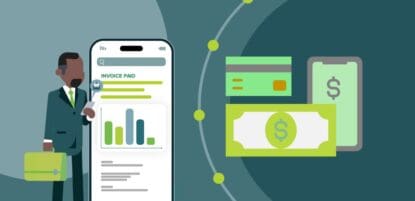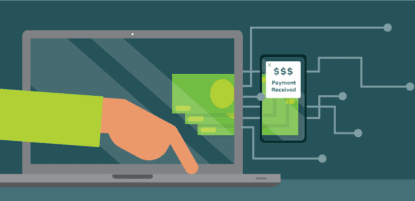The age of disruptive accounts payable technology is upon us. If your frontline accounting staff, department managers, and CFO all spend time manually processing invoice approvals and paper check payments, they’re being diverted from more important and meaningful work. And the worst part is, it’s wholly unnecessary.
The negative impact of outdated AP doesn’t stop with your own personnel though, as these inefficiencies are also likely to keep your vendors in the dark on overdue payments. This puts your entire company at risk of receiving a diminished level of service from vendors, and as a result, delivering a diminished level of service to customers.
What is the Accounts Payable Process?
The accounts payable process is responsible for paying vendors and suppliers for goods or services purchased by a business. In many cases, the process can be broken down into four steps:
- Step 1: Invoice Capture
- Step 2: Invoice Approval
- Step 3: Payment Authorization
- Step 4: Payment Execution
While the core processes are clear, the manual inefficiencies and remediation of errors are a time consuming process that can stunt the growth of a business. That’s why it’s important that AP teams turn to automation tools to assist in this process.
6 Ways Automation Streamlines the Accounts Payable Process
Automating the accounts payable process benefits businesses by helping to achieve optimal cash flow and requiring minimal manual intervention. Here’s a look at what your accounts payable process would look like if you were leveraging cutting edge automation technology, like MineralTree’s TotalAP:
1. Accelerated and Accurate Invoice Data Capture and Coding
While this step is typically the most time consuming part of an AP employee’s day, automation technology can accelerate the process by 3x. Physical invoices are electronically recorded at 99.5% accuracy by leveraging a combination of Optical Character Recognition technology and human review. Invoices can be uploaded directly into your ERP through an API-level integration with your AP automation solution. This type of integration can facilitate a bi-directional sync that transfers data back and forth like this continuously.
Automating this step eliminates many errors that result from the monotony of manual data entry. It also prevents the cost of time resources for remediating those errors downstream from ballooning up to 10x the cost of catching them initially.
2. Centralized Approval Routing
From there, the invoices can be routed directly to the appropriate person for approval based on pre-set routing rules. These rules can be set based on criteria like vendor name, and you can also set dollar amount thresholds that trigger a requirement for two tiers of approval.
3. Segregation of Duties
Automated accounts payable processes build the critical payment control of segregation of duties into the process of paying every single invoice. With 78% of businesses impacted by payments fraud last year, this basic set of checks and balances is becoming more critical than ever. An AP Manager can oversee the data capture and routing, but a second person should always authorize payments before they are disbursed.
With AP Automation, this second (and sometimes third) set of eyes can be built into the approval process for every invoice. Leading solutions have separate views for approvers, that are protected by not only passwords, but also two-factor authentication in some cases.
4. Single-Tap Invoice Approvals
Rather than managing each approval on a separate email thread, automation centralizes all outstanding approvals into one view for you, and for each department head. Within this view, invoices can be approved with a single finger tap, with more details available in cases where further inspection is needed.
This setup simplifies life for both you and your department heads, making it easier to stay on top of all required approvals, and more challenging for unpaid invoices to slip through the cracks.
5. Easy Access to Electronic Payments
With automated payments, every vendor gets paid with the method that is most advantageous to you. Do you qualify for an early-pay discount? After a streamlined approval process, an ACH transfer can easily be delivered on time. Does your commercial card program offer a cash-back rebate? It will be just as easy to pay by card.
While there are clear benefits to transitioning your vendor payments to electronic payments, leading solutions offer to facilitate check payments on your behalf as well. Regardless of which payment method you choose for each vendor, whether it be check, virtual card, ACH payments, credit card, or wire, setting up payments is just a matter of clicks with automation.
6. Single-Tap Payment Authorization
Once payments are set up in MineralTree, your controller, CFO, or payment authorizer is automatically notified. From there, they can authorize the payment with a single tap and send it on its way to your vendor. If they want to review a vendor’s payment history, they can easily do so with all of that information readily available within the payment approver view. After payment, all remittance details are delivered automatically as well.
What Your Company Looks Like with AP Automation
By automating the accounts payable process, the source of stress and strain from paying vendors shifts dramatically to a strategic advantage to your entire company. Establishing a more proactive approach to AP can have a profound effect across your business in these three areas:
Improved Vendor Service
The way you pay your vendors can make a tremendous difference in the level of service that they provide to you, and ultimately the level of service you provide to your customers. Thinking strategically about how you process and pay invoices can help you establish, build, and maintain strong relationships with vendors that help move your business forward.
Automation unlocks the time for you to establish this strategic approach. While manually processing and paying invoices can keep you busy just trying to get the bills paid on time, automating will give you the capacity to ensure every invoice is paid on time and with the most advantageous payment method.
Optimized Cash Flow
Automating gives you greater command over when you pay your vendors, enabling you to create a longer average payable period. As a result, the amount of cash the company has on hand for operations and capital expenditures increases, allowing your company to maximize the use of its trade credit by using every dollar in its cash flow.
Not only can the accounts payable team maximize capital usage, but it also has a unique opportunity to increase capital. Using virtual cards to pay vendor invoices can provide a significant, steady stream of income, as many offer cash-back rebates that can improve the performance of an organization. Automation simplifies the process of paying by virtual card as well, requiring no additional effort or process change.
Simplified Company Audits
Audits are a necessary evil for every company. But how the audit experience goes for companies has a lot to do with how the accounts payable team records and maintains their vendor invoice and payment data over the course of a year.
The easier it is to quickly locate required documentation, the less disrupted your company’s employees will be from focusing on their core responsibilities during an audit. If documentation is missing, misplaced or inaccurate, employees get pulled away from their preexisting tasks to help locate the document or correct the error. This creates a disorganized work environment that directly impacts the overall efficiency of the company. Automation preserves audit trails in a central repository for quick access at any point in the future, making audits a breeze.
In each of these areas, an accounts payable team can easily slip into reactivity. After a vendor relationship deteriorates, then they will step in and fix it. If cash flow dries up, then they find a way to expand the average payable period. If an audit occurs, then they work to retroactively clean up the paperwork and get organized. This method of operating accounts payable can hold a company back. The simplest way to take a proactive approach to accounts payable is to automate the end-to-end process.
Are you curious to see AP Automation in action? Contact MineralTree or request a personalized demo.




